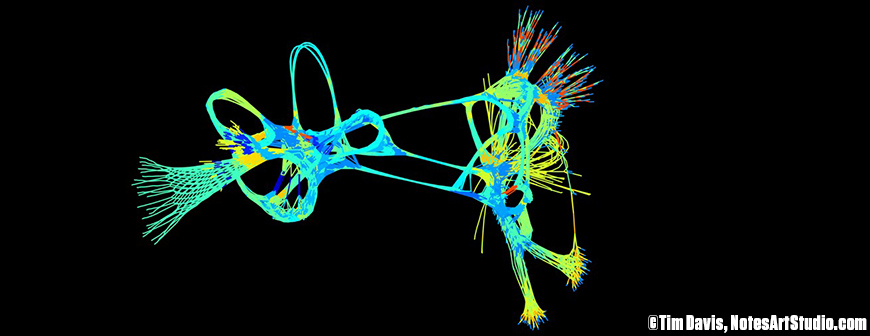
When you think of art, mathematical algorithms may not be the first thing that comes to mind. Dr. Tim Davis set out to show the world that mathematics can, in fact, be beautiful. He is merging the two disciplines by crafting algorithms that convert songs into something you can actually see.
Davis, a professor in the Department of Computer Science and Engineering at Texas A&M University, is the creator of SuiteSparse, the widely-used package of sparse matrix algorithms.
Davis collects sparse matrices from real world applications to test his solvers and to understand their performance. In collaboration with Dr. Yifan Hu, principal research scientist at Yahoo! Labs, these matrices are converted into images via the open source graph visualization package, Graphviz. For this to work, electrical charges are placed on the nodes and springs on the edges. A physics simulation is then performed to find a low-energy state. Long edges are displayed in blue and short edges in red.
These images are not only scientifically useful to gain a better understanding of how these matrices react in various scenarios, but also they are exquisite in their own right.
As a result of this work, Davis was asked by organizers of the London Electronic Arts Festival to create similar images from sound bites. He was excited to take on the challenge because of his passion to share with others his love for math and the beauty he sees within the code.
“With this algorithmic translation of music into artwork, I am able to give a glimpse into the beauty of mathematical software that everyone can see, not just me,” Davis said.
By capturing time and frequency, and remapping that into a new domain of space and color, Davis was able to build a new mathematical algorithm that captures the visual essence of an entire piece of music in a single image. Each line in an image is a note at a specific point in time in the music. Low notes are displayed in blue and high notes in red.
The genre of the music can be seen in the images. Regular meshes appear in some images because of the regular beat of jazz or modern music. Fuzzy complex graphs appear from very complex orchestral music.
“Math is so incredibly beautiful; it just takes the right eyes to see it,” Davis said, “or it needs translation into a medium that everyone can see. That is what I have tried to do with my algorithmic artwork.
“There is no true visualization of any one piece of music. Part of the artistic process resides in creating thousands and sometimes tens of thousands of images, and selecting the one that best represents the song.”
Davis’ SuiteSparse code, which is currently being used by many institutions and organizations to solve large matrix problems, continues to be successful due to its unwavering reliability.
Davis said that the only way he can achieve the level of reliability for which his code has come to be known is to ensure that it is beautiful in his own eyes.
In addition to turning music into art, Davis is also a published poet. To view his artwork and poetry, visit http://notesartstudio.com.